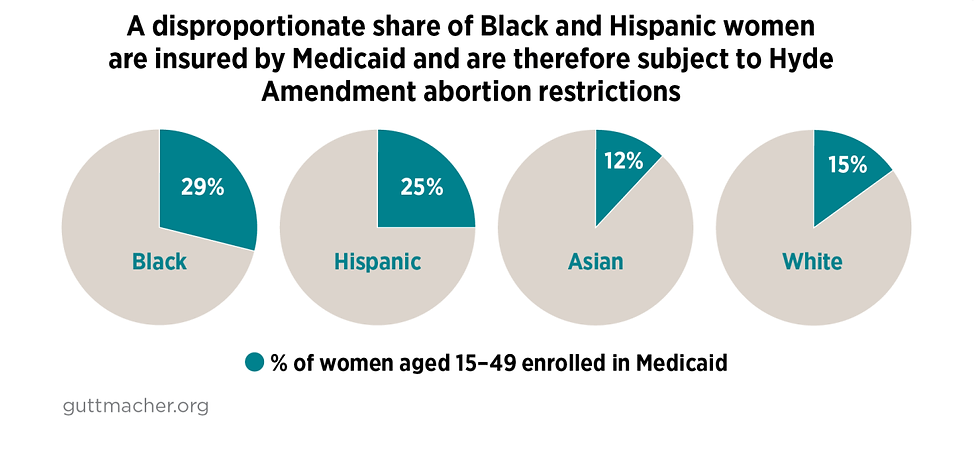
There's been a lot of chatter on Pro-Life forums the past day or so over Trump's enforcement of this amendment, with some people celebrating victory over Planned Parenthood. Before busting out the virtual confetti, we decided to dig a little deeper and see what's really going on.
Understanding the Hyde Amendment
The Hyde Amendment is like the unsung hero of U.S. abortion policy — steadfast, enduring, and probably rocking a cape somewhere. First passed by Congress in 1976, it bans federal funds from paying for most abortions, with exceptions for rape, incest, or when the mother’s life is at risk.
A Quick History Lesson
First things first: The Hyde Amendment isn’t a standalone bill, and it’s definitely not a constitutional amendment (despite what the name might suggest). It’s more like the small print on a big-budget package—a legislative provision that gets tacked onto annual appropriations bills, specifically those funding the Department of Health and Human Services. It’s been around since 1976, surviving year after year as part of the broader budget process. In practice, this means the Hyde Amendment is less of a permanent law and more of a recurring bargaining chip, used to secure votes and push budget deals through Congress. Its continued existence depends entirely on the political makeup of Congress and the priorities of the sitting president.
Back in the 70s, after the Supreme Court’s Roe v. Wade decision legalized abortion nationwide, lawmakers found themselves in a moral and political quandary. On one hand, they’d just opened the door to abortion on demand; on the other, they drew the line at asking taxpayers to bankroll it. It’s almost as if they knew Roe v. Wade was a misstep but wanted to soften the fallout by offering a compromise that appeared, at least superficially, less egregious.
Initially, the amendment only allowed federal funding for abortions to save the mother’s life. Then in 1993, exceptions for rape and incest were added because, apparently, those legislators had a hard time arguing against misguided empathy.
How’s It Been Enforced? Like a Game of Hot Potato
Depending on who’s in the White House, the Hyde Amendment has either been embraced or, well, tolerated. Here’s the play-by-play:
1976–2000: Both Democrats and Republicans agreed to keep it around, probably because debating it was exhausting.
2001–2008 (Bush Administration): Hyde got a buddy in the Mexico City Policy, which stopped international organizations from getting U.S. funds if they performed or promoted abortions. Team Pro-Life was on a roll.
2009–2016 (Obama Administration): While Hyde stuck around, critics argued that Obamacare let abortion coverage sneak in through the back door. The Affordable Care Act (ACA) allowed private insurance plans on state exchanges to include abortion coverage, with taxpayer subsidies indirectly supporting these plans. Although a "separate surcharge" was required for abortion coverage, many consumers were unaware they were paying it, leaving critics to argue the process lacked transparency. This sparked heated debates and a lot of finger-pointing.
2017–2020 (Trump Administration): In 2019, Trump’s administration put the squeeze on Title X funding, tightening the rules and cutting off cash flow to abortion providers. Cue the drama. Title X, which doesn’t technically fund abortions, often gets dragged through the mud for guilt by association. This is where things get spicy. For more info on Title X, feel free to dive down the rabbit hole in the next section.
2021–2024 (Biden Administration): President Biden tried to ghost the Hyde Amendment in his budget proposals, but Congress was like, “Nah, we’re keeping it.” Pro-life groups weren’t thrilled with the drama, but the amendment survived.
2025–Present (Trump’s Encore): Back in office, Trump signed an executive order not only enforcing Hyde but also kicking International Planned Parenthood out of the funding pool. He expanded the Mexico City Policy to redirect funds to healthcare providers who, you know, don’t perform abortions.
Title X Rabbit Hole
Title X might sound like the name of a secret government program involving aliens and black helicopters, but it’s actually a federal program started in 1970 to help low-income and uninsured individuals access family planning and preventive health care. It covers everything from birth control to cancer screenings and STI testing.
But here’s where it gets spicy: By law, Title X funds can’t be used for abortions. That said, organizations like Planned Parenthood historically received these funds as long as they kept their abortion services “separate”—a rule so loose it might as well have been written on a napkin.
In 2019, Trump decided to tighten things up. He introduced a new rule barring Title X recipients from referring patients for abortions or colocating abortion services with federally funded clinics. Planned Parenthood, predictably, threw in the towel and left the program rather than comply. Fast forward to 2021, and the Biden administration rolled back those rules, inviting abortion providers back to the Title X table. But in 2025, Trump came back swinging, reinstating the stricter guidelines and once again cutting off funds to clinics involved in abortion services. In short, Title X became the battleground for a high-stakes tug-of-war between administrations, with millions of dollars and countless lives hanging in the balance.

Impact
Low-Income Women: Medicaid is barred from covering elective abortions, which means low-income women—who make up 60% of those seeking abortions—are often faced with a choice: find another way to pay for it or reconsider the decision entirely. In some states, like California, taxpayer dollars are funneled into covering these procedures, effectively bypassing the spirit of the Hyde Amendment. This creates a fractured system across the country, where access to abortion depends on whether the state prioritizes life or funds the abortion industry.
Elective Abortions: Let’s talk numbers: 92-93% of abortions are elective (that’s not us, that’s the data). Hyde’s like, “Not on my watch,” which means a lot of women will have to cover the cost of ending their children's lives themselves.
Abortion Providers: Organizations like Planned Parenthood can’t use federal funds for abortions, but Hyde’s impact goes further. Trump’s recent move to defund International Planned Parenthood took things global, cutting off funding for groups that perform or promote abortions overseas. Looks like it’s ramen noodles for dinner in their international offices.
Culture and Politics: Hyde’s been a symbol of pro-life resilience and pro-abort frustration. For pro-lifers, it’s a moral victory: taxpayer dollars aren’t going toward something they fundamentally oppose. For pro-aborts, it’s an obstacle to “reproductive freedom” (their words, not ours).

financial impact on planned parenthood
While measures like enforcing the Hyde Amendment and defunding Title X for abortion providers have redirected taxpayer dollars and sent a strong pro-life message, the financial impact on Planned Parenthood’s bottom line has been limited. The organization lost approximately $60 million annually after withdrawing from Title X under Trump’s 2019 rules, but this was just a fraction of its overall revenue, which totaled around $1.9 billion annually in recent years. The bulk of their funding still comes from Medicaid reimbursements for non-abortion services and a robust base of private donations. Trump’s recent actions, much like his earlier policies, are more of a moral victory for the pro-life movement than a fiscal hit to Planned Parenthood. They highlight the importance of ensuring public funds don’t support abortion, even if they don’t drastically alter the financial strength of abortion providers.
Conclusion: Hyde’s Here to Stay (For Now)
The Hyde Amendment has been a cornerstone of U.S. abortion policy for nearly 50 years. Now, with Trump’s renewed enforcement and global defunding of abortion providers, Hyde’s reach has extended beyond U.S. borders. That being said, Planned Parenthood's pocketbooks are only marginally affected, so this is by no means a decisive victory. Christ is King. Let’s use this political victory as a shot of adrenaline for our souls—reigniting our mission to defend the unborn, transform hearts, and boldly reshape the culture with fresh energy and purpose.
Yours truly, Jonathan


Comments